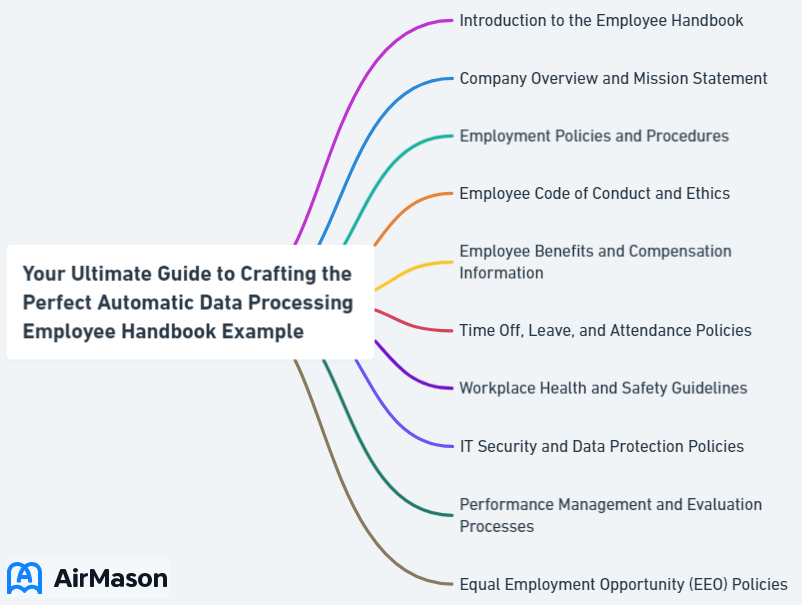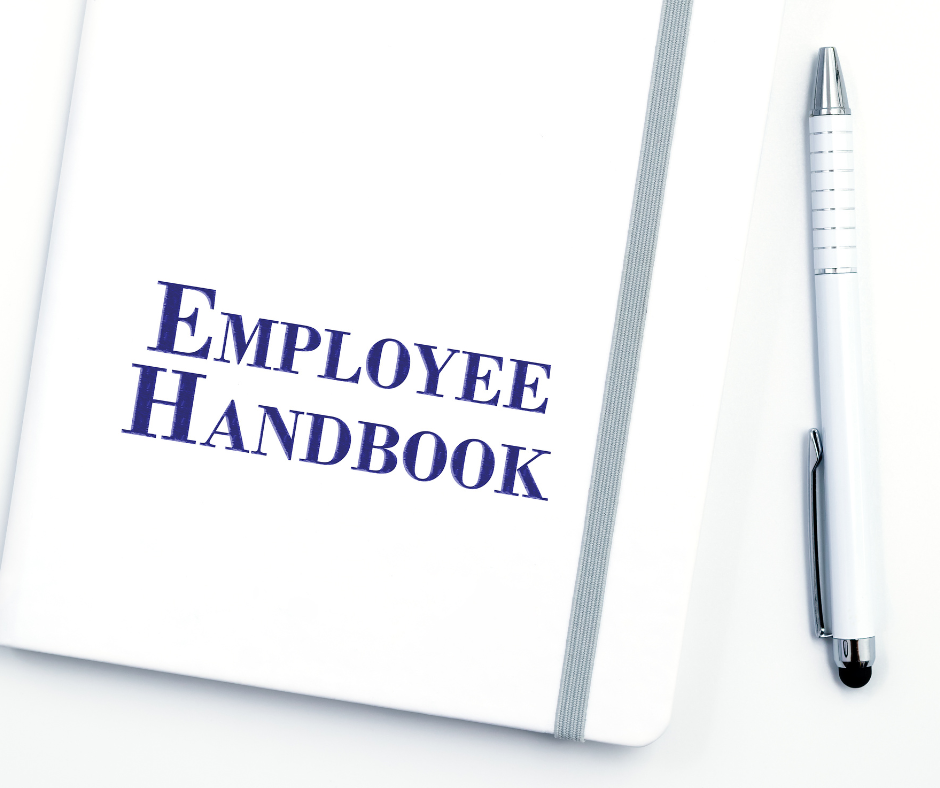
An employee handbook is a crucial tool for any organization, but creating one that is both functional and compliant with the ever-evolving world of human resource management is no small feat. In this blog post, we’ll guide you through crafting the perfect Automatic Data Processing (ADP)-compatible employee handbook, ensuring that your organization’s policies and procedures are not only up-to-date but also reflect your unique company culture. To help you get started, we’ll provide an automatic data processing employee handbook example for your reference.
Key Takeaways
- Understand Automatic Data Processing (ADP) and build an ADP-compatible employee handbook.
- Comply with state and federal regulations while customizing the handbook to reflect company culture.
- Regularly update your ADP employee handbook for compliance with changing laws, industry standards, and company policies.
Fortune 500 Companies Employee Handbook
Welcome to the comprehensive Fortune 500 Companies Employee Handbook, designed to guide you through the policies, values, and expectations that shape our workplace. This invaluable resource outlines the principles that govern our interactions, providing a roadmap for success and collaboration. Within the Fortune 500 Companies Employee Handbook, you will find essential information on professional conduct, diversity and inclusion initiatives, and the tools available to support your growth. By familiarizing yourself with this handbook, you are taking a proactive step toward fostering a positive and productive work environment. Embrace the opportunities outlined within these pages, and let’s collectively contribute to the success of our esteemed organization.
Understanding Automatic Data Processing (ADP)
Automatic Data Processing (ADP) is a global technology company that offers cloud-based human capital management (HCM) solutions, including industry-leading online payroll and HR services, tax and compliance management, and paid time off administration. With features such as automated payroll processing, HR services and compliance, benefits management, onboarding workflows, and employee self-service, ADP software helps employers manage employee data and documents efficiently and accurately.
Gaining a solid grasp of ADP is key to crafting a successful employee handbook. Here are some reasons why:
- It helps you comply with state and federal regulations
- It allows you to reflect your company’s culture
- It enables you to clearly state company policies, procedures, and expectations
- It primes your employees for success from the outset
Building an ADP-Compatible Employee Handbook
An ADP-compatible employee handbook typically includes the following components:
- Introduction and Welcome
- Employment Policies
- Code of Conduct
- Compensation and Benefits
- Time Off and Leave Policies
- Performance Expectations
- Employee Rights and Responsibilities
- Safety and Security
- Employee Resources
- Acknowledgment and Signature
The purpose of this handbook is to provide employees with a comprehensive understanding of the organization’s policies, procedures, and expectations, while also communicating effectively using the appropriate company tone and voice.
Building an effective ADP-compatible employee handbook requires consideration of both compliance with state and federal regulations and customization that mirrors your distinct company culture. The necessary steps to make sure your handbook is compliant and reflects your organization’s values will be outlined in the subsequent sections.

Compliance with State and Federal Regulations
When constructing an ADP employee handbook, it’s imperative to consider relevant state and federal regulations to ensure that the policies and procedures detailed in the handbook abide by the legal requirements at both the state and federal levels. Failure to comply with these regulations can lead to severe consequences, including:
- Penalties and fines
- Legal responsibility
- Damage to reputation
- Depletion of current or potential employees
- Decreased productivity
To ensure compliance, follow these steps:
- Research relevant state and federal employment laws.
- Consult legal experts to ensure your handbook is in line with these laws.
- Include necessary policies in your handbook, such as those related to harassment, discrimination, and employee benefits.
- Keep your handbook up to date with any changes in laws or company policies.
- Train employees and managers on the contents of the handbook and the importance of compliance.
Be sure to comply with federal employment laws like the Fair Labor Standards Act (FLSA), the Family and Medical Leave Act (FMLA), which includes sick leave, and the Americans with Disabilities Act (ADA), as well as federal and state anti-discrimination laws, such as Title VII of the Civil Rights Act of 1964 and state-specific laws. Staying alert to these regulations is crucial for your business.
Additionally, include policies regarding leave, meal and break periods, and Occupational Safety and Health Administration (OSHA) regulations and other relevant safety and health laws.
Customizing Your Handbook to Reflect Company Culture
It’s important to tailor the employee handbook to mirror your company’s culture and values accurately, as it draws and retains employees who resonate with your company’s values and fosters a unified company culture. Additionally, it ensures that the policies and procedures in the handbook are in accordance with the company’s values.
Some best practices for customizing your employee handbook to reflect company culture include:
- Aligning the language, tone, and content with the company’s values and mission
- Using clear and concise language
- Incorporating visuals and images
- Keeping the handbook up-to-date
- Making it engaging by incorporating interactive elements, such as quizzes or surveys
By following these guidelines, your employee handbook will accurately represent your organization’s unique culture and values, fostering a sense of belonging among employees.
Essential Sections for Your ADP Employee Handbook

Having established the significance of compliance and customization in creating an ADP-compatible employee handbook, we will outline the key sections that should be included. These sections cover topics such as employment basics, workplace policies, and compensation, providing clear and comprehensive guidelines for your employees.
The subsequent sections will detail each of these key segments, suggesting content and organization to help you assemble a document, such as a handbook, that is both informative and engaging for your employees.
Employment Basics and Onboarding Process
The Employment Basics and Onboarding Process section of your employee handbook sets the foundation for a successful employee experience. This section should include policies, procedures, and guidelines that create a supportive environment for employees. Some key topics to cover in this section include:
- The company’s mission, values, and culture
- Roles and responsibilities associated with various positions within the organization
- The company’s compensation structure
- Work hours, breaks, and vacation or leave policies
- Performance expectations and evaluation process
- Training and development opportunities available to employees
By including these topics, you can ensure that your employees have a clear understanding of the company and their role within it.
When it comes to the onboarding process for new employees, provide a comprehensive step-by-step guide, including orientation, paperwork, and introductions to key team members. Emphasize the importance of completing the onboarding process and include a checklist of tasks and activities to ensure all steps are completed. This will help set your new hires up for success from the very beginning.
Workplace Policies and Code of Conduct
The Workplace Policies and Code of Conduct section of your employee handbook creates a clear framework of guidelines and expectations for employees in the workplace. This section should provide examples and templates of necessary workplace policies and codes of conduct for your organization to customize. The Code of Conduct serves as an example for employee behavior, outlining expectations for how employees should interact with one another.
Some examples of important workplace policies for an ADP-compatible employee handbook include employment classifications, at-will employment, anti-harassment and non-discrimination, leave and time off benefits, code of conduct, communication policies, and compensation and performance policies. To tailor your code of conduct to your company culture, consider comprehending the company culture, recognizing key principles, involving employees, supplying examples, communicating and educating, and regularly reviewing and revising. This will help ensure that your workplace policies and code of conduct are in line with your organization’s values and expectations.
DuPont Employee Handbook Example
DuPont takes pride in providing a comprehensive and clear set of guidelines through its Employee Handbook. The DuPont Employee Handbook Example serves as a blueprint for fostering a positive work environment and ensuring that employees are well-informed about company policies and expectations. Covering a wide range of topics, from code of conduct to benefits, this handbook exemplifies DuPont’s commitment to transparency and employee well-being. By incorporating the “DuPont Employee Handbook Example” into our organizational culture, we aim to empower our workforce with the knowledge and resources needed for success.
Compensation, Development, and Performance Reviews
The Compensation, Development, and Performance Reviews section of your employee handbook ensures that employees understand how they are compensated for their efforts and how they can progress within the organization. When establishing compensation policies, review policies and procedures to ensure compliance with applicable laws and formulate concise guidelines. In addition, communicate development opportunities clearly to employees, modeling desired behaviors and skills, and establishing SMART goals for employees to strive towards.
To effectively incorporate performance review methods into your employee handbook, consider including:
- Setting clear goals and objectives for employees
- Regular check-ins and feedback sessions
- 360-degree feedback
- Performance ratings based on predefined criteria
- Self-assessment
- Development plans
Aligning compensation and performance reviews with company goals is essential for creating a cohesive employee experience and fostering a culture of continuous improvement.
Time Off, Holidays, and Leave Policies

Time off, holidays, and leave policies are highly important to employees, as they guide them on how to balance their time between work and personal commitments. When designing time off policies, consider:
- Fostering a work-life balance that encourages employees to take time off
- Clearly communicating the policy to employees
- Treating time off as vested wages once earned
- Establishing a limit on vacation accrual
- Periodically reviewing and updating the policy as your business evolves.
Creating equitable and inclusive holiday policies is essential for promoting a diverse and supportive workplace environment. Here are some steps you can take:
- Develop a holiday calendar that encompasses major cultural and religious holidays.
- Permit employees to request time off for holidays that are meaningful to them.
- Provide floating holidays or the option to exchange holidays.
- Recognize and accommodate religious holidays.
By implementing these policies, you can create a more inclusive and respectful workplace for all employees.
By crafting time off, holiday, and leave policies that cater to the diverse needs of your employees, you’ll create a positive work environment that fosters employee satisfaction and retention.
Handling Employee Resignations and Terminations
Managing employee resignations and terminations requires clear policies and procedures to secure a seamless transition for both the departing employee and the organization. In the “Leaving our company” template, matters pertinent to employee resignation and termination are addressed, providing guidance for creating policies that protect the interests of both parties.
When managing employee resignations and terminations, it’s important to:
- Obtain a resignation letter
- Fulfill any legal obligations, such as providing final pay and benefits
- Exercise caution when dismissing an employee who has made prior complaints against the company to minimize legal risks
- Have a well-defined termination policy that encompasses details regarding the termination process within the organization, including reasons for termination, notice periods, severance pay, exit interviews, and any legal considerations.
By implementing clear and fair policies for handling employee resignations and terminations, you’ll be better equipped to navigate these challenging situations with compassion and professionalism.
Implementing and Updating Your ADP Employee Handbook
It’s important to implement and keep your ADP employee handbook updated regularly to maintain compliance with changing laws and industry standards, and to accurately reflect your company’s policies and procedures. Some best practices for implementing your ADP employee handbook include:
- Clearly defining company policies and procedures
- Ensuring compliance with local labor laws and regulations
- Including a code of conduct and ethics
- Providing clear guidelines on employee benefits and compensation
- Regularly updating the handbook to reflect any changes in policies or regulations.
It’s recommended that your ADP employee handbook be updated at least annually to guarantee its compliance with evolving laws and industry standards. Conditions that may necessitate an update to your ADP employee handbook include changes in employment laws and regulations, revisions to company policies and procedures, and emerging world issues, such as AI tool usage and changing wage transparency regulations. By incorporating employee feedback through multiple and consistent feedback mechanisms and communication channels, you’ll create a well-rounded range of perspectives to consider in your handbook updates.
Summary
In this comprehensive guide, we’ve explored the process of crafting the perfect ADP-compatible employee handbook, covering topics such as understanding ADP, building a compliant and customized handbook, essential sections to include, time off and leave policies, handling employee resignations and terminations, and implementing and updating your handbook. By following the guidance provided in this post, you’ll be well-equipped to create a valuable resource for your employees, fostering a positive work environment that aligns with your company’s values and legal requirements.
Group 1 Automotive Employee Handbook Example
Welcome to the Group 1 Automotive Employee Handbook Example. In this comprehensive guide, you will find essential information about our company policies, procedures, and expectations. The Group 1 Automotive Employee Handbook serves as a valuable resource for all employees, providing insights into our organizational culture, code of conduct, and key HR policies. We encourage you to familiarize yourself with the content of this handbook to ensure a smooth integration into our work environment. Your commitment to understanding and adhering to these guidelines is crucial in maintaining a positive and productive workplace for everyone. If you have any questions or need clarification on any aspect of the handbook, please don’t hesitate to reach out to our Human Resources department.
Frequently Asked Questions
How to set up ADP payroll?
Setting up payroll requires applying for an EIN, obtaining a local or state business ID, collecting employee documents, choosing pay periods, purchasing workers’ compensation insurance, offering optional benefits and opening a payroll bank account. Following these steps will ensure a successful ADP payroll setup.
What are the key features of ADP software?
ADP software provides automated payroll processing, HR services and compliance, benefits management, onboarding workflows, shift scheduling, and employee self-service, making it an efficient human resources management tool.
How can I ensure compliance with state and federal regulations when creating an ADP-compatible employee handbook?
To ensure compliance with state and federal regulations when creating an ADP-compatible employee handbook, research relevant laws, consult legal experts, include necessary policies, keep your handbook up to date, and train employees and managers.
What are some best practices for customizing an employee handbook to reflect company culture?
Ensure the handbook’s language, tone, and content reflect your company’s values and mission, use clear and concise language, incorporate visuals and images, keep it up to date, and make it engaging with interactive elements, like quizzes or surveys, to customize an employee handbook and reflect company culture.
Important Disclaimer:
The article presented here does not serve as a representation of the company’s actual employee handbook mentioned in this article.
Our discussions and insights regarding employee handbook are based on assumptions about what may be considered significant in the companies’ policies. These assumptions are drawn from available information and industry knowledge. Readers are advised that the content provided is for informational purposes only and should not be construed as an exact reflection of any company’s official policies or procedures. For precise and accurate details regarding a company’s employee handbook, individuals should refer directly to the company’s official documentation or consult with appropriate representatives.
Please be aware that the content on this page has been generated by using artificial intelligence language models and may contain errors, inconsistencies, or outdated information. It is provided as-is without any warranties or guarantees of accuracy. We strongly recommend using this content as a starting point for further research. We disclaim any liability for damages or losses resulting from the use or reliance on this content.